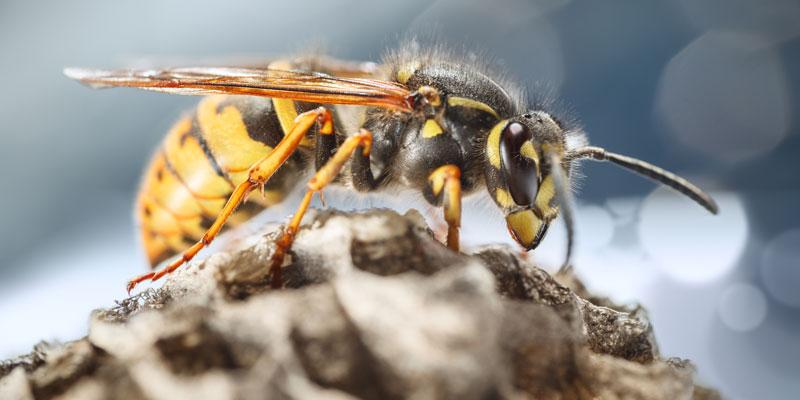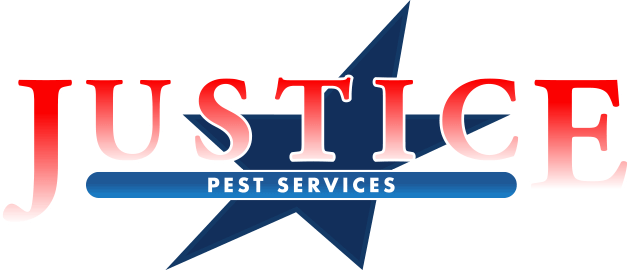Types of Wasps in Texas

Texas is home to an array of wasp species. Wasps, known for their distinct colors, body shapes, and behaviors, play a vital role in the ecosystem. Learn about the different types of wasps in Texas! These include:
- Paper Wasps
- Red Paper Wasps
- Great Golden Digger Wasps
- Mud Dauber Wasps
- Cicada Killer Wasps
- Yellow Jackets
- Potter Wasps
- Bald Face Hornets
Paper Wasps
Paper wasps are a diverse group of wasp species found in various regions around the world, including North America. They are known for their distinctive nest-building behavior, unique coloration, and social structure. Unlike some other aggressive wasp species, paper wasps generally exhibit a more moderate temperament, making them intriguing subjects for study and observation.
Identification and Characteristics of Paper Wasps
- Coloration: Paper Wasps come in various colors, including brown, black, and reddish-brown. They often have distinctive patterns and markings on their bodies.
- Size: These wasps are generally small to medium-sized, with lengths ranging from 0.5 to 1.5 inches.
- Body Shape: Paper Wasps have a slender body shape with a noticeable waist. They have two wings and antennas and six legs.
Paper Wasp Behavior
Paper Wasps are generally less aggressive than some other wasp species. They are not as territorial and are more tolerant of human presence around their nests. However, Paper Wasps can become defensive if they feel threatened or if their nest is disturbed. They can sting multiple times if provoked. They are beneficial insects that contribute to natural pest control by preying on insects like caterpillars and other small insects.
Red Paper Wasp
One of the most common and recognizable wasps in Texas is the Red Paper Wasp. Characterized by its vibrant red-orange coloration and papery nests, this species is often found under eaves, decks, and porch ceilings. Red Paper Wasps are known for their relatively docile nature and are beneficial for gardeners, as they feed on caterpillars and other pests.
Identification and Characteristics of Red Paper Wasps
- Coloration: The Red Paper Wasp is aptly named for its striking reddish-orange coloration. Its body displays a combination of shades, ranging from deep red to orange, making it easily distinguishable from other wasp species.
- Size: Red Paper Wasps are of medium size, with adults typically measuring around 0.75 to 1 inch in length.
- Body Shape: Their body shape is slender, with a distinct waist and elongated legs. The wings are often a lighter shade than the body.
Red Paper Wasps Behavior
Red Paper Wasps are generally considered less aggressive than other wasp species. They are more likely to avoid conflict and only sting in self-defense when they feel threatened. However, if their nest is disturbed, they may become defensive and sting to protect their territory. These wasps are beneficial to gardens and ecosystems as they feed on various insects, including caterpillars and spiders. This makes them valuable for natural pest control.
Great Golden Digger Wasps
This solitary wasp species is easily identifiable by its striking black body and colorful wings. The Great Golden Digger Wasp is a proficient hunter, preying on grasshoppers and crickets to feed its larvae. Although they may seem intimidating due to their size, these wasps are generally non-aggressive and rarely sting humans.
Identification and Characteristics of Great Golden Digger Wasps
- Coloration: The Great Golden Digger Wasp is named for its black body with metallic golden wings. This coloration is one of its most distinguishing features.
- Size: These have an average length of about .5 to 1 inch.
- Body Shape: Great Golden Digger Wasps have a robust and elongated body, characterized by their distinct "waist." Their legs are long and sturdy.
Great Golden Digger Wasps Behavior:
Despite their potentially intimidating appearance, Great Golden Digger Wasps are not aggressive toward humans. They are solitary insects and are focused on hunting prey for their offspring rather than engaging in territorial behaviors. These wasps are important pollinators as they visit flowers while foraging for nectar. Their role in pollination contributes to the reproductive success of various plant species.
Mud Dauber Wasps
Mud Dauber Wasps are skilled builders, crafting their nests from mud and attaching them to walls, ceilings, and other structures. These nests resemble elongated tubes and can often be found in sheltered areas. Mud Dauber Wasps are beneficial predators, as they capture spiders and paralyze them to provide a fresh food source for their offspring.
Identification and Characteristics of Mud Dauber Wasps:
- Coloration: Mud Dauber Wasps vary in color depending on the species, but they often have a predominantly black body with markings that can range from yellow to metallic blue or green.
- Size: These wasps are generally an average length of about 1.5 to 2 inches.
- Body Shape: Mud Dauber Wasps have a slender, elongated body with a distinct waist. Their legs are long and spindly, and their antennae are also long and often curved.
Mud Dauber Wasps Behavior:
Mud Dauber Wasps are generally solitary insects and not known to form colonies. They are not aggressive towards humans and are unlikely to sting unless directly handled or provoked. These wasps are more focused on hunting spiders and providing for their offspring than on engaging in territorial behavior. Mud Dauber Wasps are considered beneficial insects as they help control spider populations. They target various types of spiders, including orb-weavers and other common species.
Cicada Killer Wasp
Among the largest wasp species in Texas, the Texas Cicada Killer Wasp is an impressive sight. With a wingspan that can reach up to two inches, these wasps are known for their distinctive black and yellow coloration. Despite their intimidating appearance, Texas Cicada Killers are primarily focused on hunting cicadas and are not aggressive toward humans.
Identification and Characteristics of Cicada Killer Wasps
- Coloration: Cicada Killer Wasps have a distinctive coloration, with a black body marked by pale yellow stripes and markings. Their abdomen often displays alternating yellow and black bands.
- Size: These wasps are among the largest in North America, with females measuring around 1.5 to 2 inches in length. Males are slightly smaller.
- Body Shape: Cicada Killers have a robust and muscular body with a stripe of yellow across their middle section. Their legs are brightly colored and adapted for digging. They also typically have amber-colored wings.
Cicada Killer Wasps Behavior
Despite their large size, Cicada Killer Wasps are not typically aggressive toward humans. Male wasps are more territorial and can be seen engaging in aerial combat over mating territories, but they lack stingers. Female Cicada Killers are equipped with a potent sting for paralyzing their prey, but they are not prone to stinging humans unless directly handled or threatened. Cicada Killer Wasps are primarily focused on capturing and provisioning their nests with cicadas. The cicada population they control through their hunting behavior can have ecological benefits.
Yellow Jackets
Yellow Jackets are notorious for their aggressive behavior and painful stings. While various species of Yellow Jackets can be found in Texas, they share common traits such as yellow and black striping on their bodies and a preference for sugary foods. These social wasps build their nests underground, and their presence at picnics or outdoor events can be a nuisance.
Identification and Characteristics of Yellow Jackets
- Coloration: Yellow Jacket Wasps are named for their distinct black and yellow coloration. They have alternating bands of black and yellow on their abdomen, thorax, and head.
- Size: Yellow Jackets are generally small to medium-sized wasps, with lengths ranging from ⅜ to ⅝ inches.
- Body Shape: They have a narrow waist and they have four clear but slightly yellow wings.
Yellow Jackets Behavior
Yellow Jacket Wasps are known for their aggressive behavior, especially when their nests are threatened. They can sting repeatedly, and their stings can be painful, causing allergic reactions in some individuals. They are scavengers and often scavenge for human food at picnics, outdoor events, and trash cans.
Yellow Jackets are attracted to sugary substances, which is why they can become a nuisance at
outdoor gatherings. It's best to cover food and keep trash containers tightly sealed to minimize their presence.
Potter Wasp
Potter Wasps are named for their intricate nest-building skills, which involve creating small, vase-shaped structures from mud. These nests are often attached to plants, fences, and other outdoor surfaces. Potter Wasps are valuable pollinators and pest controllers, as they consume caterpillars and other insects.
Identification and Characteristics of Potter Wasps
- Coloration: Potter Wasps can be commonly confused with yellow jackets, as they are typically black with yellow stripes.
- Size: These wasps are generally pretty small to medium-sized, with lengths ranging from ⅜ to ¾ inches long.
- Body Shape: Potter Wasps have a slender and smooth body shape. Their body segments are often well-defined, and they have relatively long antennae.
Potter Wasps Behavior
Potter Wasps are not generally aggressive toward humans and are unlikely to sting unless directly provoked or handled. Potter Wasps are important pollinators as they visit flowers while foraging for nectar. Additionally, they help control caterpillar populations, making them valuable for maintaining ecosystem balance.
Bald-Faced Hornets
The Bald-faced Hornet, despite its name, is not a true hornet but rather a type of yellow jacket wasp. This species is recognized for its distinct black and white coloration, with white markings on its face and abdomen. Although it can be mistaken for a hornet due to its appearance, the Bald-faced Hornet is known for its aggressive behavior and painful stings.
Identification and Characteristics of Bald-Faced Hornets:
- Coloration: The Bald-faced Hornet's coloration is its most distinctive feature. Its body is predominantly black, with white markings on its face, thorax, and abdomen.
- Size: These wasps are relatively large, with worker hornets measuring around ¾ to ⅞ inches in length.
- Body Shape: Bald-faced Hornet’s midsection looks slightly triangular from the side, but their most distinct attribute is their coloring.
Bald-Faced Hornets Behavior
Bald-faced Hornets are known for their defensive nature, especially when their nests are threatened. These hornets will attack when their space is invaded. It's important to exercise caution around their nests to avoid provoking an aggressive response. If you encounter a nest on your property, it's advisable to contact a pest control professional to safely remove it.
